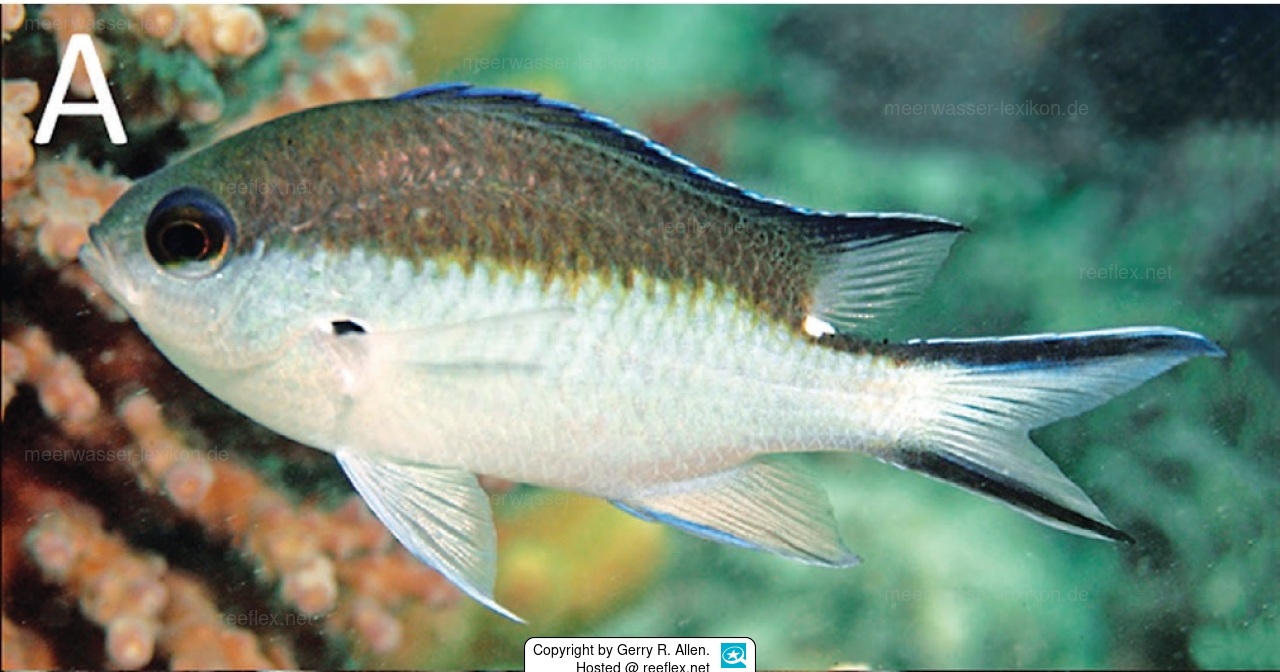Info
Chromis norfolkensis is currently known from the northern Tasman Sea and the southern Coral Sea region of northern New Zealand, Norfolk Island, New Caledonia and the Chesterfield Islands
The damsel has also been observed and photographed in New South Wales, Australia, near Sydney and Swansea.
Habitat:
These damselfishes are typically found on outer reef slopes around boulders or occasionally on coral patch reefs.
Adults are dark to light brown or yellowish (hence the New Zealand name Yellow Demoiselle), on the upper half and white on the lower half, the transition between the two halves more or less abrupt with slightly diagonal demarcations extending from the lower posterior corner of the eye to a conspicuous small rounded white spot half the size of the pupil or less.
At the base of the last dorsal-fin rays, the dorsal fin tapers to brown at the tip with gradation distally to nearly black, darkest on the outer two-thirds of the anterior half of the soft portion of the fin, the remainder of the fin translucent, and the outer margin of the entire dorsal fin narrowly pale blue to bluish white.
Anal and pelvic fins are white with narrow bluish anterior margin, caudal fin is translucent whitish to bluish with broad black bands along upper and lower margins with a narrow blue-white margin.
Pectoral fins are translucent with a black spot covering the outer portion (fin side) of the axillae and projecting slightly into the dorsal margin of the fin base.
Remarks.
The new species was previously thought to be a southern population of Chromis fumea, a species restricted to the northwestern Pacific (primarily Japan and Taiwan).
Etymology. This species has been named after the type locality, Norfolk Island in the southwestern Pacific Ocean.
Scientific source:
Allen, Gerald R., & Allen, Mark G. (2021).
Two new species of Chromis (Teleostei: Pomacentridae) from northwestern Australia and the southwestern Pacific Ocean, previously part of C. fumea (Tanaka, 1917).
Journal of the Ocean Science Foundation, 38, 78–103.
https://doi.org/10.5281/zenodo.5601971
The damsel has also been observed and photographed in New South Wales, Australia, near Sydney and Swansea.
Habitat:
These damselfishes are typically found on outer reef slopes around boulders or occasionally on coral patch reefs.
Adults are dark to light brown or yellowish (hence the New Zealand name Yellow Demoiselle), on the upper half and white on the lower half, the transition between the two halves more or less abrupt with slightly diagonal demarcations extending from the lower posterior corner of the eye to a conspicuous small rounded white spot half the size of the pupil or less.
At the base of the last dorsal-fin rays, the dorsal fin tapers to brown at the tip with gradation distally to nearly black, darkest on the outer two-thirds of the anterior half of the soft portion of the fin, the remainder of the fin translucent, and the outer margin of the entire dorsal fin narrowly pale blue to bluish white.
Anal and pelvic fins are white with narrow bluish anterior margin, caudal fin is translucent whitish to bluish with broad black bands along upper and lower margins with a narrow blue-white margin.
Pectoral fins are translucent with a black spot covering the outer portion (fin side) of the axillae and projecting slightly into the dorsal margin of the fin base.
Remarks.
The new species was previously thought to be a southern population of Chromis fumea, a species restricted to the northwestern Pacific (primarily Japan and Taiwan).
Etymology. This species has been named after the type locality, Norfolk Island in the southwestern Pacific Ocean.
Scientific source:
Allen, Gerald R., & Allen, Mark G. (2021).
Two new species of Chromis (Teleostei: Pomacentridae) from northwestern Australia and the southwestern Pacific Ocean, previously part of C. fumea (Tanaka, 1917).
Journal of the Ocean Science Foundation, 38, 78–103.
https://doi.org/10.5281/zenodo.5601971







 Dr. Gerald (Gerry) Robert Allen, Australien
Dr. Gerald (Gerry) Robert Allen, Australien











































































